If you are a child of the 60’s & 70’s like I am, you probably remember the
Lava Lamp. Heck, maybe some of you even still have one on a shelf somewhere! The
original motion lamp was designed by engineer Edward Craven Walker in 1963 and
was named the Astro Lamp. Then in 1965, it was discovered by two American’s at a
German tradeshow and was brought back to the US and sold as the now famous Lava
Lamp.

The lamp itself consists of a fully enclosed glass cone that is filled with
water and ‘lava’. The actual recipe for the ‘lava’ is of course a trade secret.
When plugged in, a light bulb in the base heats up the lava which begins to
float to the top of the cone. The effect looks like… you guessed it: lava :o)
Although Lava Lamps were popular back in the days of hippies and daisies,
they are still cool and mesmerizing. Enter the
Laserpod, a 21st Century version
designed by Light Artist Chris Levine
and world-renowned photographer Mario
Testino.
Package Contents
Aluminum Laserpod projection light unit
Electroplated tall dome diffuser
Electroplated short dome diffuser
Ridged glass refractor lens
AC adapter
Instruction booklet
Safety Leaflet
Unlike the Lava Lamp, the Laserpod doesn’t employ liquids to create its
unique moving light display. Instead it uses a laser light that is refracted
through a spinning Swarovski crystal in the base unit.
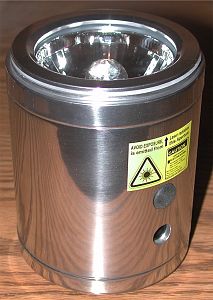
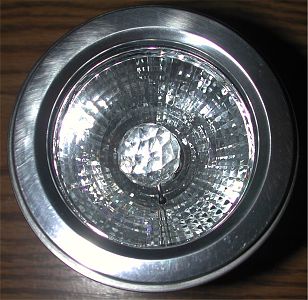
The polished aluminum base is sturdy and heavy enough that it will not easy
tip over. The words Laserpod are etched on the front of the base, and a
rubber covered push button is located on the back. The button is both a power
toggle and color toggle for the lamp. By default, the lamp glows purple / blue
with red flecks. If you press the button a 2nd time, the lamp color will switch
to red with lighter red highlights.
The Laserpod can display light in several different ways:
In a dark room
If you just plug it in and turn it on without a diffuser dome or the refractor
disk, it will create a light show on the ceiling and walls that gives a definite
space / alien type of vibe. Points of red light dance slowly across the ceiling
while swirls of either red or blue make up the background.
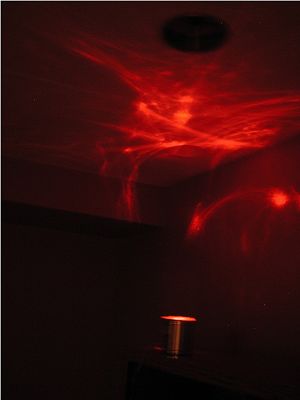
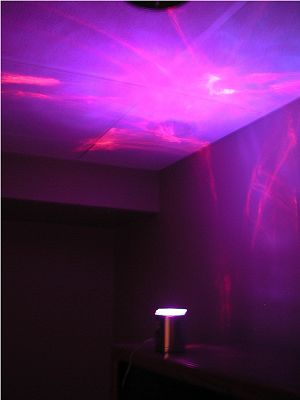
Add the refractor disk, and the light changes to more of an Aurora Borealis
type of show. Using the Laserpod in these two configurations is probably my
favorite way to use it. I have found that leaving it on in a dark bedroom is a
great way to unwind before going to sleep.
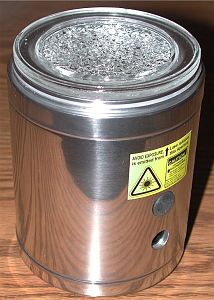
On a desktop in a lighted room
Using either the short or tall diffuser dome, the Laserpod turns into the modern
day equivalent of the Lava Lamp. Points of light swirl around inside the dome
and sides to create a feeling of movement that is hypnotic to watch. You can
also use the refractor disk with the dome to change the light slightly. Either
way, it makes a cool kaleidoscope of blues and reds. It’s too bad that blue and
red are the only colors though. I’d love to see greens, oranges, and more.
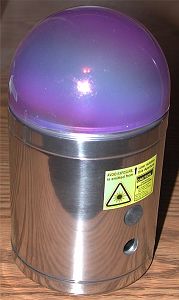
With the short dome, the Laserpod is 6 inches tall, and with the tall dome it
is 11 inches tall.
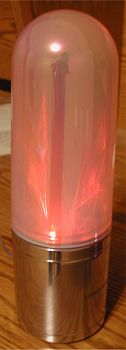
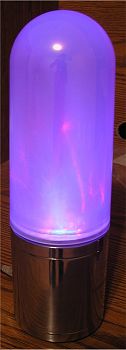
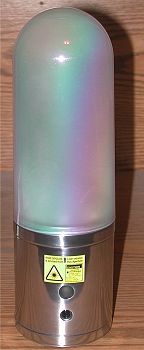
Red light, Blue & Red, Off
The Laserpod base and dome do not get hot even when left on for hours a time.
Virtually silent (there is a slight buzzing/hum) while powered on), this product
makes both an unusual conversation piece and art piece.
With a price tag of $100, this isn’t exactly a product that everyone will
rush right out and buy, but it would make a great gift for a techie friend that
you never know what to buy for. It will definitely find a spot in my remodeled
office when the renovations are complete.
Price: $99.00
Pros:
Hypnotic
Makes an interesting conversation piece
Cons:
Expensive
Need more colors
Google Review Tap Cards (3-Pack) by TapFive - Tap for Instant Reviews - All Phones Compatible - Reusable Smart Tap NFC & QR - Boost Business Reviews - Powered by TapFive (3 Card Pack)
$34.90 (as of December 5, 2025 17:55 GMT -05:00 - More infoProduct prices and availability are accurate as of the date/time indicated and are subject to change. Any price and availability information displayed on [relevant Amazon Site(s), as applicable] at the time of purchase will apply to the purchase of this product.)REVLIXI Google Review Stand -Boost Reviews w/Reusable Google Review Tap Card Stand & QR Code Stand- No App or Subscription - Android & iPhone Compatible-Boost Google Reviews for Online Growth
$24.89 (as of December 5, 2025 17:55 GMT -05:00 - More infoProduct prices and availability are accurate as of the date/time indicated and are subject to change. Any price and availability information displayed on [relevant Amazon Site(s), as applicable] at the time of purchase will apply to the purchase of this product.)Product Information
| Price: | 99.0 |
| Manufacturer: | Laserpod |
| Pros: |
|
| Cons: |
|



Gadgeteer Comment Policy - Please read before commenting
Post your comments here on the Laserpod Review.
http://www.the-gadgeteer.com/laserpod-review.html
Just click the POST REPLY button on this page.
They really need to make it sound activated so that it responds to the music playing in the room.
dsunde:
Great idea! 😀
I just bought a Laserpod. It literally arrived the next day via UPS ground (WA to OR is usually one day). I’ll add a few bits of info not present in the review:
The packaging is rather Apple-inspired and nicely done. Internally the unit consists of three red laser diodes and three blue/violet LEDs. These six emitters are aimed at the slowly spinning crystal. The crystal is about 3/4″ diameter and is the multi-faceted kind some people hang from their rear-view mirrors. It seems to have a clock motor spinning it, so it rotates about once a minute, thus the projected patterns do repeat about once a minute. Adding the refraction glass on top of the unit creates an endless possibility for new patterns depending on how you orient it.
The unit runs off batteries for a long time. Mine is still on its original set of 3 AAs. That includes letting it run overnight once when I fell asleep watching the patterns on the ceiling.
What I would like to see as an improvement would be a socket for a tripod or mounting bracket. This would allow mounting the unit for projecting horizontally onto a wall, or down onto the floor. Two of these units projecting onto a floor or ceiling would be interesting.
One of the best uses for this thing is an endless form of entertainment for cats. They will chase the red dots around, which is especially amusing if you add some catnip to the mix.
I’m having an issue with mine.
From the “off” position, I press the button once and the blue LED’s come on. I press the button once more and the red laser dots turn on BUT, the blue LED’s go off? One more press of the switch turns the unit “off”. So I can only have the blue lights (which the crystal in the centre doesn’t spin) or the red laser dots (which the crystal does spin) I can’t have both?
Has my unit died or is there a simple fix for it?
Also I run it on alkaline batteries only as I have misplaced the power pack for it when moving house.